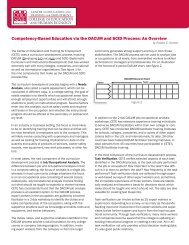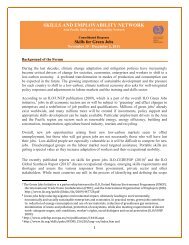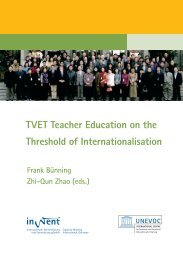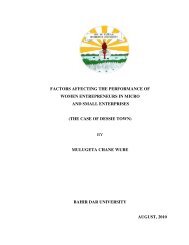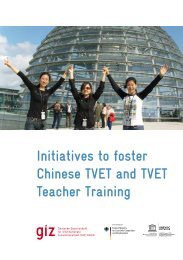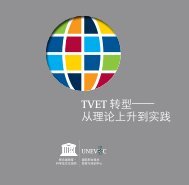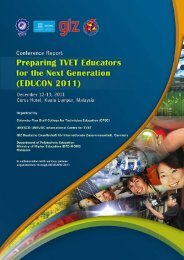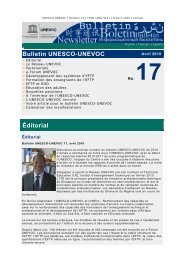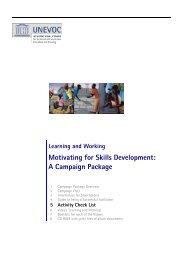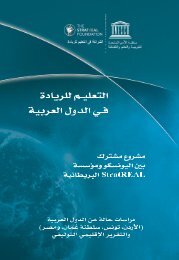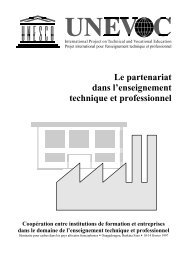Lifelong learning and training: a bridge to the future - Unesco-Unevoc
Lifelong learning and training: a bridge to the future - Unesco-Unevoc
Lifelong learning and training: a bridge to the future - Unesco-Unevoc
Create successful ePaper yourself
Turn your PDF publications into a flip-book with our unique Google optimized e-Paper software.
students away from higher education <strong>and</strong> <strong>to</strong> supply <strong>the</strong> necessary manpower required by <strong>the</strong><br />
industries.<br />
To streng<strong>the</strong>n <strong>the</strong> links between schools <strong>and</strong> industry, especially in <strong>the</strong> areas of technical<br />
education <strong>and</strong> <strong>training</strong>, a new system named “<strong>the</strong> Two-plus-one Program” was introduced in<br />
1994 <strong>and</strong> was implemented in forty designated model schools in 1998. The programme<br />
comprises two years of vocational education in schools, followed by one year of practical<br />
‘h<strong>and</strong>s-on’ field <strong>training</strong> in industrial companies. From 1999, <strong>the</strong> implementation of this system<br />
has been left <strong>to</strong> <strong>the</strong> discretion of technical senior secondary schools.<br />
Beginning in 1994, <strong>the</strong> Presidential Commission for Educational Reform (PCER)<br />
examined <strong>the</strong> effectiveness of <strong>the</strong> policies <strong>to</strong> exp<strong>and</strong> enrolment figures for vocational senior<br />
secondary schools <strong>and</strong> <strong>to</strong> encourage close industry-school linkages. By <strong>the</strong> end of 1995, it was<br />
concluded that some of <strong>the</strong> earlier policy measures were inappropriate. PCER recommended<br />
certain changes in <strong>the</strong> policies, placing emphasis on quantitative expansion of vocational senior<br />
secondary school enrolment <strong>to</strong> that of placing more emphasis on <strong>the</strong> quality improvement of<br />
vocational education.<br />
PCER proposed <strong>the</strong> Second Educational Reform Programme including <strong>the</strong> vocational<br />
education reform in 1996. Reflecting recent trends in higher education, <strong>the</strong> objective of <strong>the</strong><br />
vocational education reform is <strong>to</strong> establish a ‘<strong>Lifelong</strong> Vocational Education System’. In order <strong>to</strong><br />
achieve this goal, legislation on <strong>the</strong> credit bank system in 1996 was enacted, allowing part-time<br />
registration <strong>to</strong> college on a test base system. In addition, students in vocational senior secondary<br />
schools <strong>and</strong> workers in industry are able <strong>to</strong> continue fur<strong>the</strong>r education. These students have<br />
priority in <strong>the</strong> selection process for entry in colleges in related fields of study.<br />
With <strong>the</strong> introduction of a lifelong education system, <strong>the</strong> junior college education was<br />
exp<strong>and</strong>ed. Between 1979 <strong>and</strong> 1997, <strong>the</strong> enrolment in junior colleges increased 11 times <strong>and</strong> <strong>the</strong><br />
programmes were diversified, from 91 in<strong>to</strong> 361. Based on <strong>the</strong> Educational Reform Programme,<br />
<strong>the</strong> cus<strong>to</strong>mized <strong>training</strong> system responding <strong>to</strong> industrial dem<strong>and</strong>s has been implemented in two<br />
model junior colleges since 1996 <strong>and</strong> plans are underway <strong>to</strong> exp<strong>and</strong> <strong>the</strong> programme. In order <strong>to</strong><br />
streng<strong>the</strong>n <strong>the</strong> junior colleges’ capacity for vocational education, programmes linking <strong>the</strong><br />
curriculum of <strong>the</strong> second <strong>and</strong> third years of vocational senior secondary schools with that of <strong>the</strong><br />
vocational college (2+2) are being implemented in some pilot schools. Students who have<br />
completed vocational senior secondary school courses are given priority in <strong>the</strong> selection process<br />
for entry in<strong>to</strong> colleges in related fields of study. From 1996, <strong>the</strong> graduates of junior colleges<br />
receive associate degrees.<br />
As <strong>the</strong> required production skills became increasingly sophisticated with <strong>the</strong><br />
manufacturing of higher value-added products in <strong>the</strong> late 1980s, companies began <strong>to</strong> emphasize<br />
skills upgrading for <strong>the</strong>ir workers while placing less emphasis on <strong>the</strong> initial <strong>training</strong> for trainees<br />
prior <strong>to</strong> employment. Even though <strong>the</strong> compulsory <strong>training</strong> levy system contributed <strong>to</strong> <strong>the</strong> early<br />
increase of in-plant <strong>training</strong>, it failed <strong>to</strong> encourage companies <strong>to</strong> invest in <strong>the</strong> fur<strong>the</strong>r education<br />
<strong>and</strong> <strong>training</strong> of <strong>the</strong>ir workers. To encourage enterprises <strong>to</strong> provide fur<strong>the</strong>r <strong>training</strong> of those in<br />
employment, <strong>the</strong> government has introduced <strong>the</strong> vocational competency development scheme<br />
with <strong>the</strong> enactment of <strong>the</strong> Vocational Training Promotion Act in 1999. All companies with more<br />
than fifty employees are required <strong>to</strong> provide vocational competency development programmes<br />
for <strong>the</strong>ir employees <strong>and</strong> for job seekers.<br />
Since <strong>the</strong> latter part of 1997, <strong>the</strong> Republic of Korea has been suffering from ever-<br />
∼ 24 ∼



